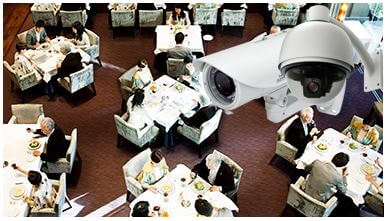As a restaurant owner, protecting your employees and customers is probably one of the most challenging parts of your job. Drawing customers into your restaurants for increased business must be balanced with the concerns of crime, loss, liability, food safety and security.
Restaurant owners and managers should consider a proactive approach to their security program. From quick serve and fast casual to fine dining, four best practices can be taken to protect against losses and increase the safety of employees and customers in the restaurant environment:

1: Complete a Risk Evaluation. A thorough risk evaluation from a local technology provider will help give an objective review of your existing security plan, identify vulnerabilities and pinpoint opportunities for areas where you can efficiently reduce risk. The risk assessment should be completed by a knowledgeable and reputable provider for each and every location. Be sure to discussing typical concerns like restaurant entrances, food product storage areas and cash POS stations, you should review areas that may need monitoring, like vendor delivery areas and ventilation system access. Review crime statistics around your business to help you determine the potential for the rate of crimes in your area, as well as what crimes are common. Determine nearby businesses, including those businesses with that are not similar to yours that might be more likely to attract a customer base that could potentially increase the crime rate.
2: Install or Upgrade Your Security Technology. Based on findings from your risk evaluation, you may need to install or upgrade your security technology. The solution may include a combination of intrusion detection with monitoring and video surveillance. These solutions will help increase the profitability of your restaurant by reducing losses from false alarms or employees giving-away merchandise without charge to friends and family. Your chosen solution should allow you to have an audit trail of critical areas of your business and employees at all times.
Key components of your physical security program should include:
- Intrusion detection system, back door alarms and motion detectors to protect from burglary
- Video surveillance system with DVR and cameras placed to monitor entrances, the drive-thru, parking lots, POS terminals, food prep areas, and manager office
- Public view monitors to deter crime, since criminals are less likely to strike when it is clear they are under surveillance
- Appropriate security surveillance signage posted in plain sight at entrances and throughout property
3: Regularly Train Employees on Your Security Program. Training employees is a critical component of executing an effective restaurant security program. Employees must be trained regularly on cash handling policies, as well as how to handle security-related incidents, such as a robbery.
Installing cameras at various locations is the first step in monitoring activities, but your employees should be aware that they are being monitored. Instructing employees that you will be observing for incidents like cash theft, food and beverages, as well as passing free food items to friends and family, will help deter these forms of employee theft. Regularly training employees on the proper use of the security systems can ensure that employees, customers and assets are protected and help avoid false alarms. As you implement your plan and integrate your security systems, engage your employees in the plan. Soliciting feedback and support will communicate to your employees that they are valuable assets to the team.
4: Evaluate and Monitor the Effectiveness of the Security Plan As your security plan is implemented, it is important evaluate the effectiveness of that plan. Evaluate them regularly and consistently. When actual security incidents occur, debrief and document the details for training purposes, and change your security plan as necessary. Security planning is cyclical, so it is important to regularly revisit your plan starting with step one. As your restaurant grows or changes, you will want to consider scheduling a product technology update with your security provider in order to ensure you are applying the most effective solutions available within your budget
Establishing an effective, proactive restaurant security program can increase security and safety for your employees and customers, while contributing to the company’s overall profitability. By applying these steps in your approach, you can help to protect against losses and keep your customers and employees safe and secure.
